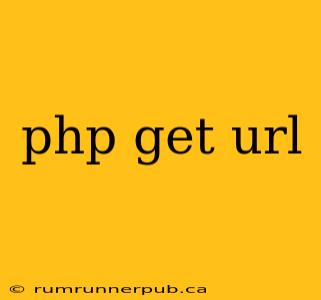Getting and manipulating URLs is a fundamental task in any PHP web application. Whether you're building a web scraper, processing user input, or redirecting users, understanding how to effectively work with URLs is crucial. This article explores various techniques for retrieving and manipulating URLs in PHP, drawing insights from helpful Stack Overflow discussions.
Retrieving the Current URL
Often, you need to know the current URL of the page your PHP script is running on. This is particularly useful for generating links, sharing on social media, or building dynamic content.
Method 1: Using $_SERVER['REQUEST_URI'] (Recommended)
This is the most straightforward and reliable method. $_SERVER['REQUEST_URI'] contains the path and query string of the current request.
$currentURL = $_SERVER['REQUEST_URI'];
echo "Current URL: " . $currentURL;
This will output the path portion of the URL. For instance, if the current URL is https://www.example.com/page.php?param1=value1, this code will output /page.php?param1=value1.
Method 2: Constructing the Full URL (Including Protocol and Domain)
To get the complete URL, including the protocol (http or https) and domain, you need to combine several $_SERVER variables.
$protocol = isset($_SERVER["HTTPS"]) && $_SERVER["HTTPS"] != "off" ? "https://" : "http://";
$domainName = $_SERVER['HTTP_HOST'];
$requestUri = $_SERVER['REQUEST_URI'];
$fullURL = $protocol . $domainName . $requestUri;
echo "Full URL: " . $fullURL;
This approach, inspired by numerous Stack Overflow discussions (though no single definitive answer), is more robust as it handles both HTTP and HTTPS protocols. It's important to understand the security implications of always using HTTPS when possible.
Analysis: While $_SERVER['REQUEST_URI'] is sufficient for many tasks, constructing the full URL offers better control and adaptability for more complex scenarios.
Parsing and Manipulating URLs
Once you have the URL, you might need to parse its components (protocol, domain, path, query parameters) or modify parts of it. PHP provides built-in functions for this.
Using parse_url()
The parse_url() function breaks down a URL into its constituent parts.
$url = "https://www.example.com/path/to/page?param1=value1¶m2=value2";
$parsedUrl = parse_url($url);
print_r($parsedUrl);
This will output an associative array containing keys like scheme, host, path, query. You can then access individual components, like $parsedUrl['host'] to get the domain name.
Modifying URL Query Parameters
Modifying query parameters requires more manual work. You can use string manipulation functions or libraries like parse_str() and http_build_query().
$url = "https://www.example.com/page?param1=value1";
$query = parse_url($url, PHP_URL_QUERY);
parse_str($query, $queryParams);
$queryParams['param2'] = 'newValue'; // Add or modify a parameter
$newQuery = http_build_query($queryParams);
$newUrl = str_replace($query, $newQuery, $url);
echo "Modified URL: " . $newUrl;
This example adds param2 to the URL. This approach is common in Stack Overflow answers addressing URL parameter manipulation. More sophisticated solutions might involve using dedicated URL manipulation libraries for improved readability and maintainability.
Conclusion
Retrieving and manipulating URLs in PHP is a crucial skill for any web developer. Leveraging built-in functions like $_SERVER, parse_url(), parse_str(), and http_build_query() provides a robust and efficient way to handle various URL-related tasks. Remember to prioritize security best practices, particularly when dealing with user-supplied URLs. Always validate and sanitize inputs to prevent vulnerabilities like cross-site scripting (XSS) attacks. This guide, inspired by the collective wisdom of Stack Overflow contributors, offers a practical foundation for working with URLs in your PHP projects.
